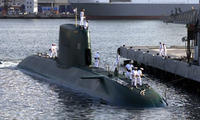-
Rocket-propelled life preserver saves victims from drowning
A new rescue device ingeniously buys more time for a rescuer to ready a response and reach a drowning victim; borrowing the design of a rocket-propelled grenade, the new rescue system fires an expanding foam bullet up to 500 feet; once the bullet hits the water, it expands forty-times its original size into a life preserver; because the bullet is made of foam, even if it strikes the victim, it would do as much damage as a tennis ball
-
-
Sector Report for Tuesday, 5 October 2010: Emergency / Police / Mil.
This report contains the following stories.
Plus 1 additional story.
-
-
Number of extremist, hard-to-police Web sites skyrockets
The number of extremist Web sites has skyrocketed, expanding from 12 in 1998 to 4,500 in 2006; Western authorities say that taking action to remove them remains difficult; different countries have adopted different approaches to the problem
-
-
The five fantastic flying machines from the Pentagon
DARPA has given a Maryland-based company $3 million to develop a flying Humvee; the Pentagon’s restless research arm has an impressive track record when it comes to audacious flying machine ideas — some of which have never made it off the drawing board, while others are still being pursued
-
-
Daytime shotgun tracer ammunition developed
Two companies collaborate to produce the world’s first non-pyrotechnic shotgun tracer; ChemiTracer creates a daytime visible trace that travels with the cloud of the shot allowing shooters instantly to determine how to correct their aim
-
-
USB thumb drive for cybersecurity missions
New USB thumb drives designed for military, intelligence, and law enforcement cybersecurity missions; the device boots in less than three seconds, then automatically scans and copies data by prioritizing search criteria and securely partitions search results for analysis
-
-
Raytheon engineers show Iron Man suit
The new robotic suit enables the wearer easily to lift 200lb several hundred times without tiring and repeatedly punch through three inches of wood; yet, the suit, which was developed for the U.S. Army, is also agile and graceful enough to let its wearer kick a football, punch a speed bag, or climb stairs and ramps with ease
-
-
Norway bans testing of Israel-bound submarines

Israel is buying additional submarines for two purposes: first, move some of its nuclear second-strike capabilities to sea in order to enhance its deterrence posture; second, have more cruise missile-carrying submarines available to position off the Iranian coast for possible attack on Iran’s nuclear weapons facilities; Norway, which is critical of Israel’s occupation of Palestinian territories, has informed the German builder of the Israel-bound submarines that Norway will no longer allow deep-water testing of these submarines in the Norwegian submarine base the German company had leased
-
-
Mexican mayors: Returning criminal Mexicans to border towns increases violence
A coalition of Mexican mayors say the United States is contributing to the increase in violence in Mexican border towns by busing repatriated Mexicans who committed crimes in the United States to these border towns — where they join the ranks of the drug cartels — rather than drive or fly them back to their home towns
-
-
Taser shotgun in legal trouble in U.K.
Taser’s new, powerful eXtended Range Electronic Projectile, or X12, is being evaluated by the U.K. Home Office for possible adoption by U.K. police; before the evaluation has been completed, the British importer of the weapon sold it to the Northumbria police, in the north of England, which used it against fugitive Raoul Moat, who died as a result; the Home Office has now revoked the importer’s license
-
-
Brazil uses chemical "fingerprints" to trace trafficked cocaine
Brazilian federal police have used chemical profiling to determine that cocaine is being trafficked into the country via new routes; they are now compiling the most comprehensive database of the chemical fingerprints of illicit drugs in South America, which will be used to pinpoint where the cocaine is originally made
-
-
Police use of technology drives property crime to 20-year low
Law enforcement authorities say that the growing use of technology once accessible only to a few large agencies allows officers to conduct real-time analyses of burglaries, petty thefts, and car thefts; the result: U.S. property crime has fallen to a 20-year low despite the sour economy
-
-
Iran admits its nuclear facilities are under massive cyberattack

Iran has confirmed that 30,000 computers in the country’s power stations, including the nuclear reactor in Bushehr, have been attacked by the Stuxnet worm; the Stuxnet worm is described by experts as the most complex piece of malware ever designed; once Stuxnet gains access to a plant’s computers, it hunts out specific software that controls operations such as the opening and closing of valves or temperature regulation; by halting those processes it can cause extensive damage to nuclear power stations, power grids or other industrial facilities; the high number of infections in Iran have led experts to conclude that the worm may have been designed in the United States or Israel to disable Iran’s controversial nuclear facilities
-
-
Fast DNA analysis for law enforcement unveiled
The cost and complexity of current forensic DNA analysis methods have contributed to significant processing backlogs throughout the criminal justice system; Lockheed Martin and ZyGEM Corp. unveil a new platform that uses recent developments in microfluidic research and development to accelerate the DNA identification process
-
-
Experts: Israel used cyber weapon to disrupt Iran's nuclear reactor

The Stuxnet malware has infiltrated industrial computer systems worldwide in July and August; now, cyber security experts say that the worm was, in fact, is a search-and-destroy cyber weapon meant to hit a single target — Iran’s Bushehr reactor; Stuxnet amazed — and stunned — computer security experts: too large, too encrypted, too complex to be immediately understood, it employed amazing new tricks, like taking control of a computer system without the user taking any action or clicking any button other than inserting an infected memory stick; in Stuxnet, the world faces a new breed of malware that could become a template for attackers wishing to launch digital strikes at physical targets worldwide — Internet link not required
-
More headlines
The long view
Why Was Pacific Northwest Home to So Many Serial Killers?
Ted Bundy, Gary Ridgway, George Russell, Israel Keyes, and Robert Lee Yates were serial killers who grew up in the Pacific Northwest in the shadow of smelters which spewed plumes of lead, arsenic, and cadmium into the air. As a young man, Charles Manson spent ten years at a nearby prison, where lead has seeped into the soil. The idea of a correlation between early exposure to lead and higher crime rates is not new. Fraser doesn’t explicitly support the lead-crime hypothesis, but in a nimble, haunting narrative, she argues that the connections between an unfettered pollution and violent crime warrant scrutiny.
Bookshelf: Smartphones Shape War in Hyperconnected World
The smartphone is helping to shape the conduct and representation of contemporary war. A new book argues that as an operative device, the smartphone is now “being used as a central weapon of war.”
